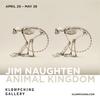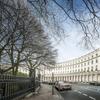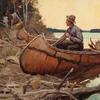Painting on Paper: American Watercolors at Princeton on View
- PRINCETON, New York
- /
- June 28, 2015
Rarely on view due to their sensitivity to light, the Princeton University Art Museum’s extensive holdings of American watercolors are distinguished by their quality and breadth as well as by the institution’s sustained commitment to the collection’s growth over time. Painting on Paper: American Watercolors at Princeton presents 90 selections from this remarkable collection, supplemented by select loans, providing a potent overview of American art as well as a survey of the importance and evolution of watercolor painting in the U.S. since the early 19th century.
Among the noted artists included in the exhibition are John James Audubon, Milton Avery, Charles Burchfield, Alexander Calder, Dorothy Dehner, Charles Demuth, Richard Diebenkorn, Arthur Dove, Thomas Eakins, Sam Francis, William Glackens, Adolph Gottlieb, Childe Hassam, Winslow Homer, Edward Hopper, Jacob Lawrence, John Marin, Claes Oldenburg, Maurice Prendergast, John Singer Sargent, Ben Shahn, James McNeill Whistler, and Andrew Wyeth.
The exhibition will be on view at the Princeton University Art Museum from June 27 through Aug. 30, 2015.
Cocurated by Laura Giles, Heather and Paul G. Haaga Jr., Class of 1970, Curator of Prints and Drawings, and Karl Kusserow, John Wilmerding Curator of American Art, at the Princeton University Art Museum, Painting on Paper features standout works from the Museum’s collection supplemented by loans from the Graphic Arts, Rare Books and Manuscripts, and Western Americana collections housed at Princeton University’s Firestone Library as well as loans from alumni and other private collections.
“Initially assembled under the museum’s pioneering director Frank Jewett Mather Jr. (dir. 1922–46), Princeton’s watercolors are first and foremost extraordinary works of art that offer unusually personal insights into the artists who made them, and taken together they also provide a compelling survey of some of the most profound works of American art,” said Princeton University Art Museum Director James Steward. “The selections in this remarkable overview afford special ways of understanding the nuanced output of many of the nation’s greatest artists.”
The works in the exhibition address broad artistic and historical trends while revealing the medium’s distinctive technical properties as an amalgam of painting and drawing. They also represent a wide range of subject matter and styles. Highlights include Winslow Homer’s Eastern Point Light (1880), an evocative portrayal of two ships, one brilliantly silhouetted by moonlight;Universalist Church (1926) by Edward Hopper, a dramatically cropped study of New England light on a historic church steeple and the structures that surround it; and Jacob Lawrence’s The Workshop (1978), whose signature flattened colors embody the artist’s modernist sensibility. Landscape plays a major role in the medium, as seen in such images as the dramatic mountain scene (ca. 1908) by John Singer Sargent, Arthur Dove’s interlocking Two Trees (1937), and the swirling forms and life-affirming spirit of Charles Burchfield’s Summer Benediction (1948). While Adolph Gottlieb’s Untitled (1946) and Alexander Calder’s The Two Arrows (1966) explore abstract shapes and formal relationships, portraiture in watercolor ranges from the traditional—Thomas Eakins’s profile of an elderly woman seated in historicized surroundings in Seventy Years Ago (1877)—to the irreverent—Claes Oldenburg’s Blueberry Pie à la Mode, Tipped Up, and Spilling (1996).
Painting on Paper: American Watercolors at Princeton has been made possible by generous support from the Kathleen C. Sherrerd Program Fund for American Art. Further support has been made possible by the New Jersey State Council on the Arts/Department of State, a Partner Agency of the National Endowment for the Arts; the Curtis W. McGraw Foundation; and the Partners and Friends of the Princeton University Art Museum.
















